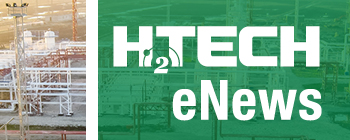News
Research reveals looming grid concerns as airports transition to H2-powered ground operations
An overwhelming 93% of European public transport leaders fear their grid connections are unable to support the shift to battery electric and H2-powered fleets, highlighting potential challenges for airport operators looking to decarbonize ground operations.
The research, commissioned by specialist engineering company IMI, surveyed 300 senior public transport professionals across the UK, Germany and Italy about H2 fuel’s adoption within the public transport sector. Against the background of H2 production expanding rapidly across Europe, IMI’s research provides insight into a less-analyzed area: the priorities and opinions of decision-makers regarding the barriers to large-scale H2 adoption.
With the decarbonization of aircraft likely to take many years, the immediate focus on reducing carbon emissions from aviation is on airport ground operations. The UK government, for instance, has a target of 2040 for airport ground operations to achieve net zero. H2 is likely to have a major role to play, with 89% of European public transport leaders questioned saying it would be effective for overcoming the limitations of battery-powered fleets, such as weight, range and grid strain – factors which translate directly to airport ground operations.
“Many hard-to-abate industries have active research and development programs concerning H2’s use as a fuel, and a viable decarbonization pathway is crucial to achieving net zero in airport operations and public transport,” said Andrea Pusceddu, Business Development Director for H2 at IMI. “Yet despite the sector's potential to benefit from the transition to greener fuels, there's little research on the views of decisionmakers invested in H2's success.
“This research aims to remedy that and has revealed striking statistics that will impact not just public transport and areas such as airports where operating passenger vehicle and ground handling operations are common. For example, 21% of respondents confirmed they had already purchased H2 vehicles, 61% said they would invest in the next 2 yr, and almost three quarters said they expect to grow their H2 fleet over the next decade.
“This last finding is particularly interesting as a majority of respondents in each region polled shared this view, further underlining that these sentiments are held across the continent. Yet only 25% of respondents said they had access to permanent fueling infrastructure, highlighting significant barriers to adoption and rollout both for public transportation and in other sectors.
“Given this situation, and the pressure on airports to decarbonize their ground operations, decentralized electrolysis is an effective solution to bridge this gap. It eliminates the distance between production and end users while allowing operators to trial vehicles without fueling stations, which will be essential for an effective rollout of H2-powered vehicles on the road or airport tarmac.”
Another challenge revealed by the research is the ability to store H2 safely – a key consideration for adoption at the scale required for airport ground operations. A total of 76% of UK respondents saying it was a significant barrier to their deployment of H2-powered vehicles, following by Italy and Germany at 73% and 66% respectively. With H2-powered fleets expected to grow, and without large-scale production and distribution infrastructure in place, the report emphasizes the importance of decentralized storage and smaller, localized electrolyzers in working around these concerns without major intervention.
“The push for more innovative and sustainable airports across Europe is not new, but this rollout must accelerate if the sector is to reach its decarbonization goals,” Mr. Pusceddu concludes. “Indeed, many across the continent have already committed to zero-emissions and zero-waste airports by 2030. While H2-fuelled vehicles will undoubtedly have an important role to play in lowering ground operations emissions, the sector cannot wait for large, centralized production to come online. Progress is needed now, and this presents a difficult situation – especially given the slower decarbonization of flight and a lack of in-house expertise in this sector.
“Indeed, this lack of familiarity can be seen in our research, where technical knowledge was the most-cited consideration by the report’s respondents when ordering new vehicles. Yet it does leave open the opportunity for closer work with developers of smaller-scale electrolyzers, such as IMI. Working this way will minimize risk and allow airport operators to demonstrate the value of H2-fueled vehicles – an important advantage given vehicles are already being ordered.”
The findings have been compiled into ‘The Road Ahead’, a new report from IMI exploring the role of decentralization for unlocking H2 as a fuel within public transport. It delves into how sector stakeholders view H2, and the challenges and steps required for wider adoption of the element as a fuel source for emerging fleets. The report goes on to analyze onsite electrolyzer technology’s potential impact on this ongoing rollout, with specific focus on Europe’s ailing electricity network.

